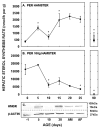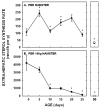The liver plays a key role in whole body sterol accretion of the neonatal Golden Syrian hamster
- PMID: 17363324
- PMCID: PMC1905147
- DOI: 10.1016/j.bbalip.2007.01.017
The liver plays a key role in whole body sterol accretion of the neonatal Golden Syrian hamster
Abstract
Neonates have a significant requirement for cholesterol. From -1 to 25 days of age, the liver accrues 6.9 mg cholesterol and the extra-hepatic tissues accrue 107.7 mg cholesterol in the hamster. It is currently unknown if each of these body compartments synthesizes their own cholesterol or if they have alternative source(s) of sterol. Using (3)H(2)O, in vivo hepatic sterol synthesis rates (per g liver per animal) increased between -1 and 5 days of age, decreased by 10 days of age, and increased again by 15 days of age. HMG-CoA reductase (HMGR) expression levels paralleled in vivo synthesis rates. Extra-hepatic sterol synthesis rates followed the same pattern as sterol synthesis rates in the liver. When sterol synthesis rates were converted to the mass of sterol synthesized per day, the liver synthesized 38.9 and the extra-hepatic tissues synthesized 63.9 mg cholesterol in the 26-day neonatal period. Comparing the amount of cholesterol accrued to that synthesized, one can conclude that the liver is a major source of sterol for the whole body during the neonatal period of the hamster. These results may help elucidate the cause(s) of reduced growth rates in neonates with liver disease or in neonates with compromised sterol synthesis rates.
Figures






Similar articles
-
Adult sterol metabolism is not affected by a positive sterol balance in the neonatal Golden Syrian hamster.Am J Physiol Regul Integr Comp Physiol. 2005 Mar;288(3):R561-6. doi: 10.1152/ajpregu.00353.2004. Epub 2004 Nov 18. Am J Physiol Regul Integr Comp Physiol. 2005. PMID: 15550619
-
Origin of cholesterol in the fetal golden Syrian hamster: contribution of de novo sterol synthesis and maternal-derived lipoprotein cholesterol.J Lipid Res. 1996 Jun;37(6):1246-57. J Lipid Res. 1996. PMID: 8808759
-
Sterol synthesis in vivo in 18 tissues of the squirrel monkey, guinea pig, rabbit, hamster, and rat.J Lipid Res. 1983 Mar;24(3):303-15. J Lipid Res. 1983. PMID: 6842086
-
Rates of sterol synthesis and uptake in the major organs of the rat in vivo.J Lipid Res. 1981 May;22(4):551-69. J Lipid Res. 1981. PMID: 7276735
-
Inability to fully suppress sterol synthesis rates with exogenous sterol in embryonic and extraembyronic fetal tissues.Biochim Biophys Acta. 2007 Nov;1771(11):1372-9. doi: 10.1016/j.bbalip.2007.09.002. Epub 2007 Sep 26. Biochim Biophys Acta. 2007. PMID: 17950663 Free PMC article.
Cited by
-
Dietary fat impacts fetal growth and metabolism: uptake of chylomicron remnant core lipids by the placenta.Am J Physiol Endocrinol Metab. 2011 Aug;301(2):E416-25. doi: 10.1152/ajpendo.00619.2010. Epub 2011 May 17. Am J Physiol Endocrinol Metab. 2011. PMID: 21586694 Free PMC article.
-
Hepatic bile acid metabolism in the neonatal hamster: expansion of the bile acid pool parallels increased Cyp7a1 expression levels.Am J Physiol Gastrointest Liver Physiol. 2009 Jul;297(1):G144-51. doi: 10.1152/ajpgi.90515.2008. Epub 2009 Apr 23. Am J Physiol Gastrointest Liver Physiol. 2009. PMID: 19389801 Free PMC article.
-
Use of hamster as a model to study diet-induced atherosclerosis.Nutr Metab (Lond). 2010 Dec 10;7:89. doi: 10.1186/1743-7075-7-89. Nutr Metab (Lond). 2010. PMID: 21143982 Free PMC article.
-
Influence of maternal hypercholesterolemia and phytosterol intervention during gestation and lactation on dyslipidemia and hepatic lipid metabolism in offspring of Syrian golden hamsters.Mol Nutr Food Res. 2016 Oct;60(10):2151-2160. doi: 10.1002/mnfr.201600116. Epub 2016 Jun 23. Mol Nutr Food Res. 2016. PMID: 27213832 Free PMC article.
References
-
- Dietschy JM, Turley SD, Spady DK. Role of liver in the maintenance of cholesterol and low density lipoprotein homeostasis in different animal species, including humans. J Lipid Res. 1993;34:1637–1659. - PubMed
-
- Cavender CP, Turley SD, Dietschy JM. Sterol metabolism in fetal, newborn, and suckled lambs and their response to cholesterol after weaning. Am J Physiol. 1995;269:E331–E340. - PubMed
-
- Cruz MLA, Wong WW, Mimouni F, Hachey DL, Setchell KD, Klein PD, Tsang RC. Effects of infant nutrition on cholesterol synthesis rates. Pediatr Res. 1994;35:135–140. - PubMed
-
- Bayley TM, Alasmi M, Thorkelson T, Krug-Wispe S, Hones PJH, Bulani JL, Tsang RC. Influence of formula versus breast milk on cholesterol synthesis rates in four-month-old infants. Pediatr Res. 1998;44:60–67. - PubMed
-
- Irons M, Elias ER, Salen G, Tint GS, Batta AK. Defective cholesterol biosynthesis in Smith-Lemli-Opitz syndrome. Lancet. 1993;341:1414. - PubMed
Publication types
MeSH terms
Substances
Grants and funding
LinkOut - more resources
Full Text Sources

